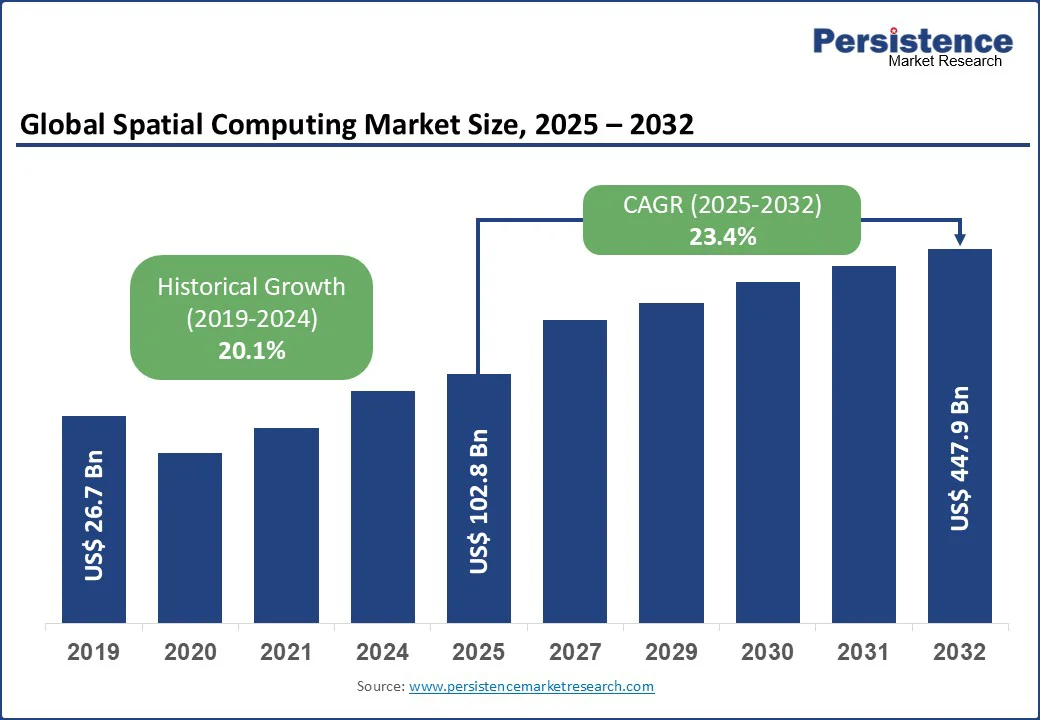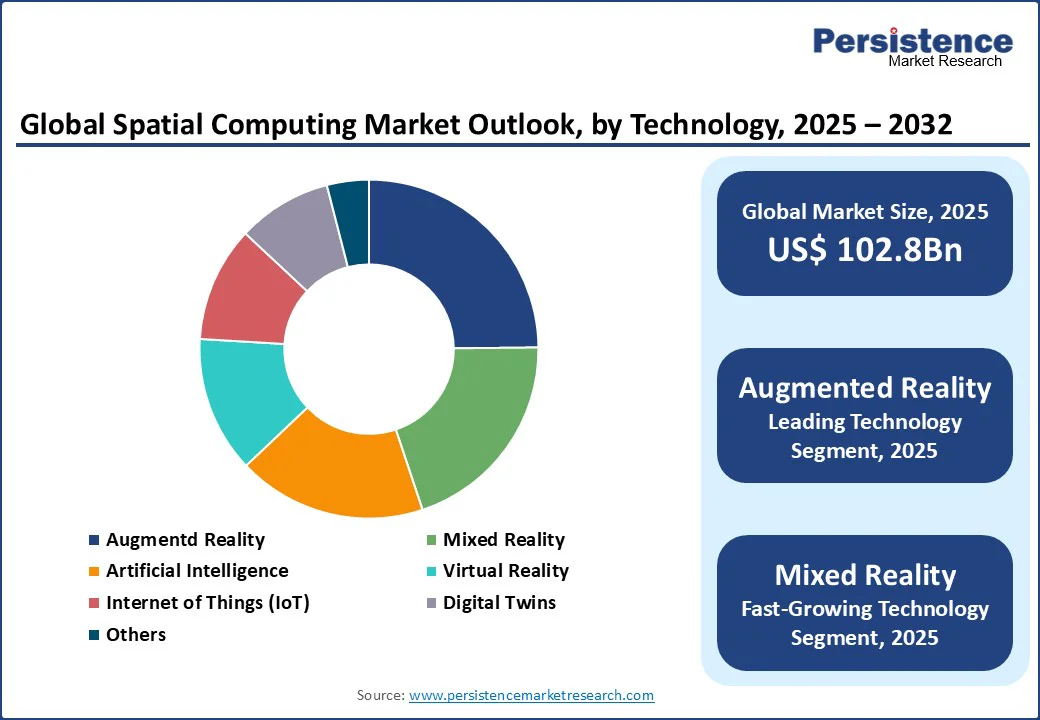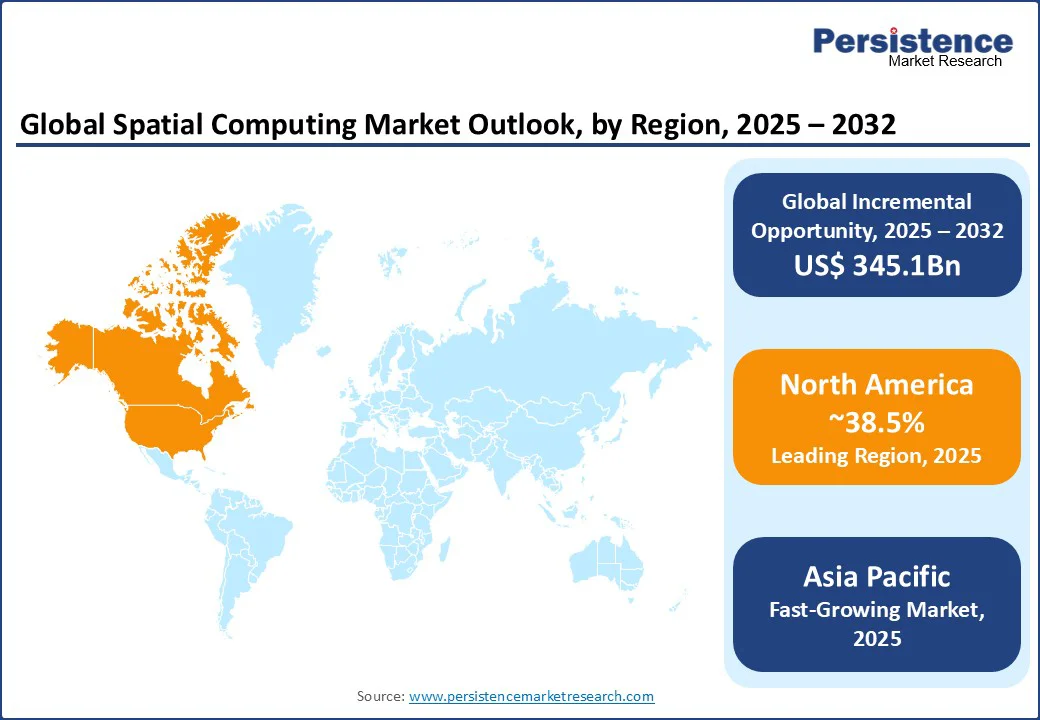ID: PMRREP32998| 188 Pages | 4 Sep 2025 | Format: PDF, Excel, PPT* | IT and Telecommunication

The global spatial computing market size is likely to be valued at US$102.8 Bn in 2025 and reach US$447.9 Bn by 2032, growing at a CAGR of 23.4% during the forecast period from 2025 to 2032.
Spatial computing, encompassing augmented reality (AR), virtual reality (VR), mixed reality (MR), and related technologies, is revolutionizing industries by enabling immersive digital experiences and seamless interaction with physical environments. The Spatial Computing market is driven by increasing adoption in gaming, healthcare, and architecture, engineering, and construction (AEC), fueled by advancements in hardware, AI integration, and IoT connectivity. Rising investments in smart city initiatives and Industry 4.0 further propel market growth, with key players innovating to meet diverse application needs.
Key Industry Highlights

|
Global Market Attribute |
Key Insights |
|
Spatial Computing Market Size (2025E) |
US$ 102.8Bn |
|
Market Value Forecast (2032F) |
US$ 447.9Bn |
|
Projected Growth (CAGR 2025 to 2032) |
23.4% |
|
Historical Market Growth (CAGR 2019 to 2024) |
20.1% |
The spatial computing market is experiencing robust growth due to surging demand for immersive technologies in gaming and entertainment. AR and VR technologies provide interactive and realistic experiences, driving adoption in gaming, live events, and media. According to Statista, the global gaming market is expected to reach $522.46 billion by 2025, with AR/VR gaming contributing significantly.
Companies such as Oculus (Meta) and Sony Group Corporation are launching advanced headsets, such as the Meta Quest 3 and PlayStation VR2, enhancing user engagement. The rise of esports and virtual concerts, with events such as Fortnite’s virtual concerts attracting millions, further fuels demand. In North America, the U.S. gaming industry relies heavily on spatial computing for immersive gameplay. Government support for digital innovation, such as Canada’s Media Fund, ensures sustained investment, positioning gaming as a key driver for market expansion through 2032.
The spatial computing market faces challenges due to high development and deployment costs, coupled with technical complexities. Advanced AR/VR hardware, such as high-resolution headsets and spatial sensors, requires significant investment, limiting adoption among smaller enterprises. In 2024, the average cost of a premium VR headset, such as the Apple Vision Pro, exceeds $3,000, making it inaccessible for cost-sensitive markets.
Additionally, integrating AI, IoT, and digital twins demands sophisticated infrastructure, posing challenges for scalability. Limited standardization in software platforms and interoperability issues further hinder adoption, particularly in developing regions. These factors, combined with the need for skilled expertise, restrain market growth, especially in price-sensitive sectors such as education and small-scale AEC projects.
The growing focus on healthcare and professional training presents significant opportunities for the spatial computing market. AR and VR technologies are transforming medical training, surgical simulations, and patient care by providing immersive, risk-free environments. According to the World Health Organization in 2021, global spending on health reached a new high of US$9.8 trillion, accounting for 10.3% of global GDP, with spatial computing playing a key role in telemedicine and diagnostics.
Companies such as Microsoft, with HoloLens 2, are enabling remote surgical guidance and 3D anatomical modeling. In training, spatial computing enhances workforce skills in industries such as aerospace and automotive, with Boeing using AR for assembly training, reducing errors by 30%, per industry reports. Government initiatives, such as the EU’s Horizon 2030 program, support digital health innovations, creating opportunities for manufacturers to develop tailored solutions, driving market growth through 2032.

North America dominates the spatial computing market, holding a 38.5% share in 2025, propelled by robust technological innovation, high R&D investment, and strong demand in gaming and healthcare in the U.S. and Canada. The U.S. gaming industry relies on spatial computing for immersive experiences. Canada’s healthcare sector, supported by the Canada Health Infoway, adopts AR/VR for medical training. Major players such as Microsoft, Apple, and NVIDIA dominate with extensive distribution networks and advanced products such as HoloLens and Vision Pro. The region’s focus on Industry 4.0 and smart manufacturing further drives demand for spatial computing solutions, positioning North America for rapid growth through 2032.
Asia Pacific is the fastest-growing region, driven by rapid digitalization and high consumer electronics demand in China and India. China, a global technology hub, contributes significantly, with its 14th Five-Year Plan allocating $1.4 trillion for smart infrastructure by 2030, per the National Development and Reform Commission.
India’s Digital India initiative boosts AR/VR adoption in education and healthcare. The region’s gaming industry drives demand for VR headsets. Companies such as Lenovo and Seiko Epson Corporation expand their presence, leveraging low-cost manufacturing and strong R&D. Rising industrial automation and government support ensure the Asia Pacific’s market leadership through 2032.
Europe is the second fastest-growing region, driven by stringent regulations, rising demand in automotive and healthcare, and infrastructure development in Germany and France. The European AR/VR market, valued at €35 billion in 2024 per the European Commission, supports applications in automotive design and medical training. Germany’s Industry 4.0 initiatives boost demand for MR solutions, with companies such as Siemens and PTC leading innovation. The EU’s Horizon 2030 program promotes digital health and smart city projects, increasing the adoption of AR/VR in healthcare and AEC. Companies such as Zappar Ltd. and Unity Software Inc. cater to consumer and industrial needs, ensuring Europe’s strong market growth through 2032.

The global spatial computing market is highly competitive and fragmented, with numerous international and regional players. Major companies such as Apple Inc., Microsoft Corporation, and Meta’s Oculus dominate through extensive product portfolios and global distribution networks. Regional players, such as Zappar Ltd., focus on localized AR solutions. Companies are investing in AI-driven AR/VR platforms and lightweight hardware to enhance market share, driven by demand in gaming, healthcare, and AEC.
The spatial computing market is projected to reach US$102.8 Bn in 2025.
Growing demand for immersive technologies in gaming, healthcare, and AEC, along with advancements in AI and IoT, are key market drivers.
The spatial computing market is poised to witness a CAGR of 23.4% from 2025 to 2032.
The rising adoption in the healthcare and professional training sectors is the key market opportunity.
Apple Inc., Microsoft Corporation, Oculus (Meta), and Sony Group Corporation are key market players.
|
Report Attribute |
Details |
|
Historical Data/Actuals |
2019 - 2024 |
|
Forecast Period |
2025 - 2032 |
|
Market Analysis |
Value: US$ Bn/Mn, Volume: As Applicable |
|
Geographical Coverage |
|
|
Segmental Coverage |
|
|
Competitive Analysis |
|
|
Report Highlights |
|
|
Customization and Pricing |
Available upon request |
By Component
By Technology
By End-use
By Region
Delivery Timelines
For more information on this report and its delivery timelines please get in touch with our sales team.
About Author